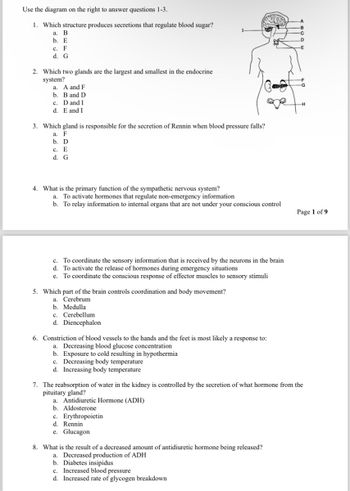
Concepts of Biology
1st Edition
ISBN: 9781938168116
Author: Samantha Fowler, Rebecca Roush, James Wise
Publisher: OpenStax College
expand_more
expand_more
format_list_bulleted
Question
please answer all if possible i need it badly and asap make sure its correct

Transcribed Image Text:Use the diagram on the right to answer questions 1-3.
1. Which structure produces secretions that regulate blood sugar?
a. B
b. E
c. F
d. G
2. Which two glands are the largest and smallest in the endocrine
system?
a. A and F
b. B and D
c. D and I
d. E and I
3. Which gland is responsible for the secretion of Rennin when blood pressure falls?
a. F
b. D
c. E
d. G
4. What is the primary function of the sympathetic nervous system?
D
-H
a. To activate hormones that regulate non-emergency information
b. To relay information to internal organs that are not under your conscious control
Page 1 of 9
c. To coordinate the sensory information that is received by the neurons in the brain
d. To activate the release of hormones during emergency situations
e. To coordinate the conscious response of effector muscles to sensory stimuli
5. Which part of the brain controls coordination and body movement?
a. Cerebrum
b. Medulla
c. Cerebellum
d. Diencephalon
6. Constriction of blood vessels to the hands and the feet is most likely a response to:
a. Decreasing blood glucose concentration
b. Exposure to cold resulting in hypothermia
c. Decreasing body temperature
d. Increasing body temperature
7. The reabsorption of water in the kidney is controlled by the secretion of what hormone from the
pituitary gland?
a. Antidiuretic Hormone (ADH)
b. Aldosterone
c. Erythropoietin
d. Rennin
e. Glucagon
8. What is the result of a decreased amount of antidiuretic hormone being released?
a. Decreased production of ADH
b. Diabetes insipidus
c. Increased blood pressure
d. Increased rate of glycogen breakdown
Expert Solution
This question has been solved!
Explore an expertly crafted, step-by-step solution for a thorough understanding of key concepts.
Step by stepSolved in 2 steps

Knowledge Booster
Similar questions
- What's the function of the hormone thymosin? A. Stimulate the development of mammary glands B. Stimulate the development of red blood cells C. Stimulate the development of T-lymphocytes D. Stimulate the development of the thyroidarrow_forwardWhich hormone stimulates phosphoprotein phosphatases to dephosphorylate glycogen phosphorylase and glycogen synthase, thus resulting in the formation of more glycogen? A. Cortisol B. Epinephrine C. Glucagon D. Insulinarrow_forwardCell signals with short effects ONLY on the cell which produced the signal in the first place are? a. juxtacrine b. autocrine c. paracrine d. endocrinearrow_forward
- Which function does the circulatory system share with the heart? Select one: a. Regulates blood pressure b. Directs blood flow to tissues c. Transports hormones to all areas of the body d. Exchanges nutrients and wastes with cellsarrow_forwardAccording to the video “The Biology of Skin Color”, what does folate deficiency in males cause? A. Cardiovascular Disease B. High sperm production C. Blindness D. Low sperm productionarrow_forwardHow does the semi-permeable nature of the cell membrane maintain homeostasis ? A. By providing two-way traffic for nutrients and waste needed to maintain metabolism. B. By creating a barrier which allows excitable cells to propagate action potentials . C. By preventing steroid hormones from entering the cell easily. D. A and Barrow_forward
- What does folate deficiency in males cause? A. Blindness B. High sperm production C. Low sperm production D. Cardiovascular Diseasearrow_forwardWhich sex hormone is most associated with beard and hair growth? a. Estrogen b. Dihydrotestosterone c. Progesterone d. Testosteronearrow_forwardWhich of the stated relationships is correct? A. the heart is inferior to the clavicle B. the shoulder is distal to the carpals C. the phalanges are proximal to the metacarpals D. the eye is medial to the eyebrowsarrow_forward
- Which statement about stem cells is false? A. Stem cells were first identified in the hematopoietic system. OB.Stem cells in organs can only differentiate into the tissue in which they are located. C. Stem cells are a subpopulation of less differentiated, self-renewing cells present in most adult tissues. D. Stem cells divide to form one daughter cell that remains a stem cell and a second cell that proliferates and then differentiates.arrow_forwardThe red blood cells are generated by? A. Spongy bone B. Red bone marrow C. Spleen D. Liverarrow_forwardThe correct alternate term for oxygen debt is ? a. Oxygen depletion b. Oxygen consumption c. EPOC d. Aerobic Metabolismarrow_forward
arrow_back_ios
SEE MORE QUESTIONS
arrow_forward_ios
Recommended textbooks for you
 Concepts of BiologyBiologyISBN:9781938168116Author:Samantha Fowler, Rebecca Roush, James WisePublisher:OpenStax College
Concepts of BiologyBiologyISBN:9781938168116Author:Samantha Fowler, Rebecca Roush, James WisePublisher:OpenStax College

Concepts of Biology
Biology
ISBN:9781938168116
Author:Samantha Fowler, Rebecca Roush, James Wise
Publisher:OpenStax College